Swiss NeWater (SNW) applications are based on the Electro Chemical Activation (ECA) that reaches simultaneously the double effect of disinfecting and cleaning. If the principle of electrolyzed water is known since many years, the technology used by the SNW is indeed very new and unique. It is based on a specific electrode, without the need of a semi-permeable membrane. A German company has patented our electrode. The invention relates to a diamond electrode synthetically produced and electrically conductive. The surface has diamond particles embedded in a metal or metal alloy layer, so as to produce a conductive connection to the metal or metal alloy. In contrast to the conventional membrane technology, the SNW can therefore offer a product with several oxidants, creating a mix of highly effective agents, leading to an ultra-effective oxidation.
Main principles:
Water electrolysis is a relatively simple process produced by giving a light electric charge to a solution of water and salt, which results in an electrochemical reaction. This process breaks the hydrogen bonds that hold the water molecules together, making an unstable solution of OH- and H+ ions. Efficiency and properties vary greatly depending on the electrode technology used, the type and quantity of mineral salt, the electrical power, as well as a few other factors. The number of such permutations and combinations is very high, hence a certain complexity to fully master the entire process. When this water enters in contact with microorganisms such as germs, bacteria or viruses, it kills them instantly by oxidation.
Common practice of water electrolysis
Russian scientists and engineers developed in the 1950’s a new form of water ionization, which was used in oil exploration. They determined that by using electrolyzed water on the permafrost surface they could dig and drill more efficiently into the tundra. Since then a number of applications spread to several types of industries.
Various electrolyzed water technologies exist and have been developed in the recent years. The efficiency of the outcome varies greatly depending on the technology used. Most of today’s electrolyzed water is produced following a membrane-based technology using metal electrodes. This technology provides mixed results and implies important maintenance costs due to corrosion. This membrane based technology produce two separate solutions:
i) An alkaline water that cleans and degreases;
ii) and an acid solution that disinfects.
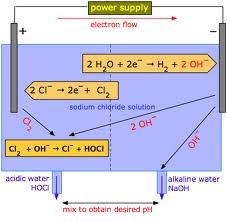
Swiss NeWater technology, how does HydroClean™ work:
The Swiss NeWater technology called HydroClean™ (trademark belonging to SNW) is a unique and patented technology that is using specific electrodes, which were developed in a long research process, which lasted several years. The use of electrodes allows the direct production of oxidants, as well as of chlorine. Oxidizing potential achieves a better cumulative effect for disinfection and cleaning.
This process will create acid and oxidizing agents like Hypochlorous acid (HOCl), Hypochlorite ion (ClO-), Hydrogen peroxide (H2O2), Ozone (O3), Sodium hypochlorite (NaClO). The oxidants contained in the water constitute a powerful biocide, which is highly effective in eliminating all forms of microorganisms (germs, bacteria, viruses, algae and spoors). To date no virus, bacteria and mold has been able to develop any adaptive resistance to HydroClean™.
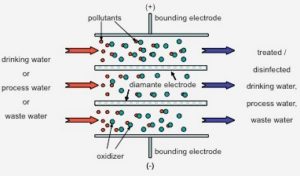
One technology, several outputs:
HydroClean™ water is based on one technology that produces different kinds of solutions depending on the desired application. Parameters such as conductivity, degree of pollution, reactor type and size, supply voltage, will generate different kinds of results. Each application implies a tailor made approach, which is part of the SNW product development strategy. For example, there is a difference between the electrolyzed water used for heavy cleaning & disinfection applications, and the water required for food processing or drinks.
Some of the most usual parameters, which can be adapted in order to generate specific outputs, are the following:
- Concentration of salt in the water: it will have a direct impact on the particles per million (ppm) obtained.
- Voltage applied on the electrodes: it will favor certain types of oxidation rather than others.
- Additives in the water will generate different chemical reactions in order to address the intended application.
- Other factors such as the quality of water, the water flow, the pressure, the temperature will all have an influence on the finalcharacteristics of the electrolyzed water.
Through a cold process, the electrolyzed water is very effective on microorganisms like germs, bacteria of all kind (including E-Coli), viruses, funguses, spores and algae. As a disinfectant, it is as or more effective than bleach or Javel water but it is not as toxic to human beings. Because our solutions are used on spot, we don’t need to stabilize them for a shelf life of several years. Therefore our solution, once the cleaning and disinfection process took place, tend to come back to water and salt. In other words, it can favorably replace many current chemical based products, with a much better environmental footprint. This technology can be used in a series of different applications, for which specific patents protect SNW. The following results have been proven.
Laboratory Testing on Bacteria, Viruses and Spores has passed several tests proving its effectiveness.
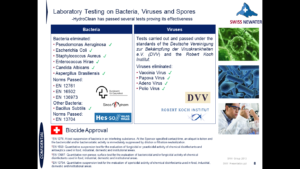
In order to scale the machines and applications, various solutions has been tested by an operational laboratory used to work in the hospital market field.
Tests proved that good disinfection level are reached after 30 seconds with an 80 ppm solution and results are excellent if time is extended to 1’ (e.g. Table 1). We tested various electrode configurations and could identify the optimal one. This is the one, which will be in our V3 machine. Nevertheless, we have already identified a much cheaper version of such electrode, slightly less performing, but with an excellent value for money.
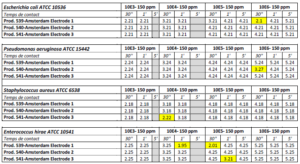
For disinfecting products, shelf life is excellent for products older than a month (e.g. Table 2)
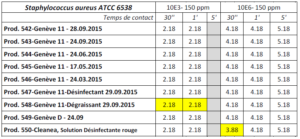
As indicated above, the electrode technology and HydroCleanTM recipes are protected by a mix of patents and know how. HydroClean’s patented technology is the result a long research process having lasted nearly 15 years. This technology allows the direct production of oxidizers with high potential and achieves a better cumulative effect for disinfection and cleaning. SNW obtained a guarantee of supply for those electrodes from their producer, with a decreasing price (according to volumes) and furthermore exclusivity for those vertical market which SNW will successfully develop. In parallel, we have also tested a much cheaper electrode, with a slightly lower disinfectant power, but with a surprisingly favorable cost / quality ratio (value for money).
Swiss NeWater and their partners had also developed applications patents. They indicate how to use practically, in some specific cases, HydroCleanTM. But their validity is to be confirmed.
